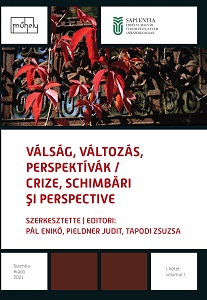A HÁBORÚ VÁLSÁGA NÉMET NEMZETISÉGI FORRÁSOKBAN ÉS FELDOLGOZÁSOKBAN
THE CRISIS OF WAR IN SOURCES AND NARRATIVES OF THE GERMAN ETHNIC GROUP IN HUNGARY
Author(s): Melinda Marinka
Subject(s): Language and Literature Studies
Published by: Scientia Kiadó
Keywords: deportation; memory; the German ethnic group in Hungary;
Summary/Abstract: One of the most shocking events of the Germans in Hungary in the 20th century was the deportation to forced labour, which created multiple crisis situations in the lives of many individuals and small communities. The population of German origin in the northeastern region of Hungary was also involved in this trauma. As a result of the events experienced, the shapes of memory and oblivion developed simultaneously. In the last 75 years, many forms of memory, adaptations, and interpretations have been created to help process trauma; therefore, we can see artistic creations in literature, visual and fine arts, but many works can also be included from a scientific point of view. In my presentation, after a brief survey of different kinds of adaptation, I will analyse the topic through a novel and other ethnographic sources. In the case of the former, Tibor Papp, in his book entitled The War Mosaic of a Little Boy [Egy kisfiú háborús mozaikja], provides an insight into the events of the history of Vállaj, one of the three Swabian settlements in Satu Mare, Hungary. This novel of a sociographic nature, like an autobiography – or a partial presentation of a life-history interview – on the one hand, helps the reader get to know the individual and the community; on the other hand, it gives the researcher the opportunity for ethnographic interpretation. Through the narratives provided by the novel, the crises of war and the cultural responses can also be examined from an ethnographic approach. In my paper, having presented Tibor Papp’s oeuvre, I will highlight Vállaj’s ethnogeographical peculiarities and its German national culture through the literary creations and my own ethnographic research. In the case of the former, it is essential how the author depicts the settlement and its population; how a crisis appears in the light of the relationship between an individual and a community. As for the German nationality, I describe some cultural phenomena and the cultural and social impacts of deportation to war and forced labour.
Book: Válság, változás, perspektívák / Crize, Schimbări şi Perspective
- Page Range: 49-64
- Page Count: 16
- Publication Year: 2021
- Language: Hungarian
- Content File-PDF

